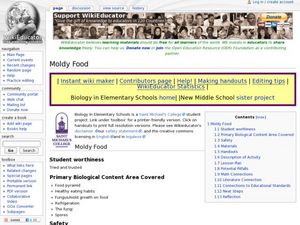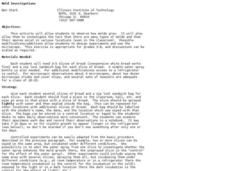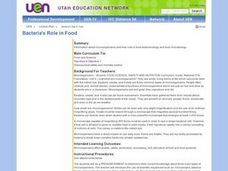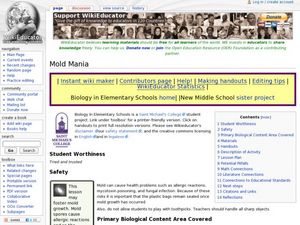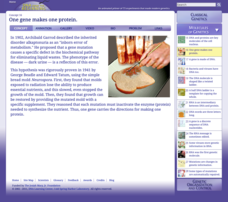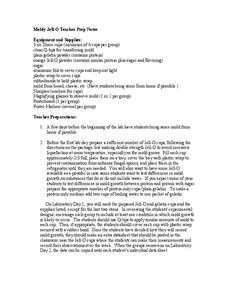Curated OER
Mold Terrarium
Students explore mold. In this mold lesson, students create a mold terrarium by using bread and a clear container. Students observe the mold grow.
Baylor College
Fungus Among Us
In order to learn that mold spores can be found in the air, observers grow bread mold and make observations for a few days. Afterward, they participate in a class discussion to arrive at the knowledge that bread spores are present in the...
Curated OER
Effects of Bread Sanitary Conditions on Mold Growth
Students examine fungi and where it comes from. For this mold lesson students determine the percentage of fruit juice in a fruit then identify the different types of mold.
Curated OER
Moldy Food
Students investigate how mold grows on food. For this mold lesson, students review the food pyramid before growing mold on different foods in Zip-Loc bags. They create graphs that show how long it takes for mold to grow on different...
Curated OER
Bread-Media
Students examine bread for microbes. For this mold growth lesson, students compare a slice of bread with saliva, a slice of bread with water and a slice of bread with mayonnaise to see which grows mold first. Students record their results.
Curated OER
This Can't be a Plant
Students grow mold. In this science experiment lesson, students grow mold on different pieces of bread by adjusting the moisture, temperature, and light. They record the results to see which grows the most mold.
Curated OER
Mold
Students explore mold, the different types and the health risks that they pose. In this mycelium lesson students grow different molds and see which type of foods mold the fastest.
Curated OER
Behold the Mold!
Students explore how mold grows on various food items. In this mold lesson plan, students predict how mold will grow on dry vs. wet food items, and chart their observations daily. Children develop a summary to aid them in a summative...
Curated OER
Mold Investigations
Learners observe mold growth on bread. In this mold growth lesson, students place bread in various locations and in various conditions to investigate how location, moisture, temperature, and other variable impact the growth of mold on...
Curated OER
Moldy Jell-O
Mini mycologists plan an experiment to determine what affects the growth of mold on gelatin. A list of available materials is provided, but the procedure needs to be designed by the lab group. A data table is also provided in which to...
NASA
Decomposers Get Energy From Dead Things
When life gives you mold, make penicillin. Scholars design an inquiry experiment to determine what causes rotting and mold growth. It also covers decomposers and the important role they play for other living things.
Curated OER
Unfold the Mystery of Mold
Students research the conditions in which molds thrive. They apply the scientific method to develop a hypothesis, conduct research and test results.
Curated OER
Grow An Apple Fungus
Students study fungus which attacks apple trees. In this apple tree lesson plan, students grow a mold to demonstrate how an apple fungus could destroy an apple tree. They observe the mold which will not actually destroy a tree. They draw...
Curated OER
Charting Mold Growth
Students chart mold growth based on food supply. In this mold growth lesson plan, students chart micro-organism growth and the decline of the growth as food runs out.
Curated OER
Bacteria's Role in Food
Students grow bacteria cultures on agar in petri dishes and do a plate count. They participate in a yogurt making lab to see how bacteria produce lactic acid. They prepare a recipe and identify fungi, fermentation and the role of...
Curated OER
Primary Biological Content Area Covered
Learners use the scientific method to make predictions about mold growth. In this fungus lesson, students use worksheets to help them illustrate predictions and graph mold growth from white to wheat bread. Learners first...
Curated OER
Who's Coming to Lunch: A Study of Mold Growth
Students participate in an experiment to determine where fungi and molds are formed, and create graphs documenting fungal growth.
Curated OER
Micros-organisms
Sixth graders examine mold with a microscope. In this micro-organisms lesson, 6th graders use teacher-prepared mold samples to prepare a wet-mount slide and examine the mold under a microscope then draw and label what they see.
Curated OER
What a Fungi
Seventh graders perform an experiment to determine the best growing conditions for molds. In this life science lesson, 7th graders explain where molds are commonly found. They collect data and draw diagrams of their observations.
Curated OER
Naked to the Eye
Students understand that microorganisms are too small to see but there are other indications they exist. In this microorganisms lesson plan, students recognize that some microorganism are helpful and some are not. Students use a...
Curated OER
All About Germs
How do people get sick? Youngsters explore the world of germs and microbes with a lab sheet and science investigation. After identifying the unhygenic practices in a picture of a kitchen, fifth graders conduct an experiment with bread...
Cold Spring Harbor Laboratory
One Gene Makes One Protein
Very few universities still offer a master's degree in the ecology of grasses, but that was the degree that led George Wells Beadle to an interest in genetics and later a Nobel Prize. Scholars learn about the discoveries of Dr. Beadle...
Curated OER
What's That Brown Fuzzy Stuff On My Plum?
Students examine Koch's Postulates by actually using them. They perform each of the required four steps to show that the brown fuzzy fungus they see growing on stone fruit (plums, peaches, nectarines, cherries) is what causes them to rot.
Curated OER
Moldy Jell-O
Students design an experiment to determine the best conditions for molds growth. In this biology lesson, students collect data for a week and analyze their findings. They create a presentation and share them with the class.





